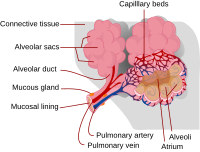
Photo from wikipedia
Background The incentive spirometer (IS) is a mechanical device that promotes lung expansion and can be used to prevent and treat postoperative pulmonary complications. In this study, the preventive effect… Click to show full abstract
Background The incentive spirometer (IS) is a mechanical device that promotes lung expansion and can be used to prevent and treat postoperative pulmonary complications. In this study, the preventive effect of pulmonary function training with IS on the improvement of pulmonary function and pulmonary complications was observed. Methods From May 2019 to April 2021, 69 scoliosis patients with impaired moderate and severe lung function were divided into the traditional pulmonary training group (n = 32) and IS-enhanced pulmonary training group (n = 35). The patient underwent lung function testing after admission and one week after the start of training and chest CT on the third day after surgery. Results The average age was 13.47 and 15.66, respectively (p = 0.223). The Cobb angles were 83.84 and 83.97 (p = 0.756), respectively, and no statistical difference between the parameters of lung function was detected. After 1 week of respiratory function training, significant improvement in lung function testing parameters including VC%, FVC%, FEV1%, FEV1/FVC, FEV1/VC, and MVV% was found in both groups. Analysis of covariance showed more significant improvement in IS-enhanced group compared to the conventional training group (p < 0.05). The incidence of postoperative pulmonary atelectasis was lower in IS-enhanced group than in traditional groups (2.9% vs. 21.9%, p = 0.043) with no difference in the overall incidence of pulmonary complications (p = 0.164) and shorter preoperative and total hospitalization in the IS-enhanced group. Conclusion Compared to traditional pulmonary function training, IS-enhanced training can significantly accelerate the improvement of pulmonary function testing parameters, shorten the preoperative pulmonary function training time, reduce the incidence of postoperative pulmonary tension complications, and accelerate postoperative rehabilitation.
Journal Title: Computational Intelligence and Neuroscience
Year Published: 2022
Link to full text (if available)
Share on Social Media: Sign Up to like & get
recommendations!